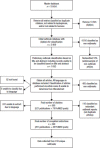A systematic literature review of leptospirosis outbreaks worldwide, 1970-2012
- PMID: 32684917
- PMCID: PMC7363284
- DOI: 10.26633/RPSP.2020.78
A systematic literature review of leptospirosis outbreaks worldwide, 1970-2012
Abstract
Objective: This review describes the geographic and temporal distribution of, detection methods for, and other epidemiological features of published leptospirosis outbreaks, with the aim of informing efforts to standardize outbreak-reporting practices.
Methods: We conducted a systematic review of leptospirosis outbreaks reported in the scientific literature and ProMED during 1970-2012. Predefined criteria were used to identify and classify outbreaks and a standard form was used to extract information.
Results: During 1970-2012, we identified 318 outbreaks (average: 7 outbreaks/year; range: 1-19). Most outbreaks were reported in the Latin America and the Caribbean region (36%), followed by Southern Asia (13%), and North America (11%). Most outbreaks were located in tropical and subtropical ecoregions (55%). Quality classification showed that there was clear description of laboratory-confirmed cases in 40% of outbreaks. Among those, the average outbreak size was 82 cases overall (range: 2-2 259) but reached 253 cases in tropical/subtropical ecoregions. Common risk factors included outdoor work activities (25%), exposure to floodwaters (23%), and recreational exposure to water (22%). Epidemiologic investigation was conducted in 80% of outbreaks, mainly as case interviews. Case fatality was 5% overall (range: 0%-60%).
Conclusions: Outbreak reporting increased over the study period with outbreaks covering tropical and non-tropical regions. Outbreaks varied by size, setting, and risk factors; however, data reviewed often had limited information regarding diagnosis and epidemiology. Guidelines are recommended to develop standardized procedures for diagnostic and epidemiological investigations during an outbreak and for reporting.
Objetivo: Describir la distribución geográfica y temporal, los métodos de detección y otras características epidemiológicas de los brotes de leptospirosis publicados con el fin de fundamentar los esfuerzos tendientes a estandarizar las prácticas empleadas en la notificación de brotes.
Métodos: Se llevó a cabo una revisión sistemática de los brotes de leptospirosis notificados en la bibliografía científica y en ProMED entre 1970 y 2012. Se utilizaron criterios predefinidos para identificar y clasificar los brotes y se empleó un formulario estándar para extraer la información.
Resultados: Entre 1970 y 2012 se identificaron 318 brotes (promedio: 7 brotes/año; rango: 1-19), la mayoría de ellos en América Latina y el Caribe (36%), región seguida por Asia meridional (13%) y América del Norte (11%). La mayoría de los brotes se localizaron en ecorregiones tropicales y subtropicales (55%). La clasificación cualitativa reveló que en el 40% de los brotes había una clara descripción de los casos confirmados por laboratorio. Entre ellos, el tamaño promedio del brote fue de 82 casos (rango: 2-2259 casos) pero alcanzó los 253 casos en ecorregiones tropicales o subtropicales. Entre los factores de riesgo frecuentes figuraban las actividades laborales al aire libre (25%), la exposición a agua proveniente de inundaciones (23%) y la exposición a agua con fines recreativos (22%). En el 80% de los brotes se realizaron investigaciones epidemiológicas, principalmente entrevistas de casos. La mortalidad específica de los casos fue del 5% (rango: 0%-60%).
Conclusiones: La notificación de brotes aumentó durante el período de estudio, y los brotes abarcaron regiones tropicales y no tropicales. Los brotes fueron diferentes en cuanto a su tamaño, el entorno y los factores de riesgo; sin embargo, los datos examinados con frecuencia incluían una información limitada respecto del diagnóstico y la epidemiología. Se recomiendan directrices para elaborar procedimientos estandarizados para las investigaciones diagnósticas y epidemiológicas durante un brote y para su notificación.
Keywords: Leptospira; Leptospirosis; disease outbreaks; public health surveillance; zoonoses.
Conflict of interest statement
Conflicts of interest. The authors declare no conflict of interest.
Figures



References
-
- Costa F, Hagan JE, Calcagno J, Kane M, Torgerson P, Martinez-Silveira MS. Global morbidity and mortality of leptospirosis: A systematic review. PLoS Negl Trop Dis. 2015;9(9):e0003898. - PMC - PubMed
- 1. Costa F, Hagan JE, Calcagno J, Kane M, Torgerson P, Martinez-Silveira MS, et al. Global morbidity and mortality of leptospirosis: A systematic review. PLoS Negl Trop Dis. 2015;9(9):e0003898. - PMC - PubMed
-
- Rood EJJ, Goris MGA, Pijnacker R, Bakker MI, Hartskeerl RA. Environmental risk of leptospirosis infections in the Netherlands: Spatial modelling of environmental risk factors of leptospirosis in the Netherlands. PLoS One. 2017;12(10):e0186987. - PMC - PubMed
- 2. Rood EJJ, Goris MGA, Pijnacker R, Bakker MI, Hartskeerl RA. Environmental risk of leptospirosis infections in the Netherlands: Spatial modelling of environmental risk factors of leptospirosis in the Netherlands. PLoS One. 2017;12(10):e0186987. - PMC - PubMed
-
- Sumi A, Telan EF, Chagan-Yasutan H, Piolo MB, Hattori T, Kobayashi N. Effect of temperature, relative humidity and rainfall on dengue fever and leptospirosis infections in Manila, the Philippines. Epidemiol Infect. 2017;145(1):78–86. - PMC - PubMed
- 3. Sumi A, Telan EF, Chagan-Yasutan H, Piolo MB, Hattori T, Kobayashi N. Effect of temperature, relative humidity and rainfall on dengue fever and leptospirosis infections in Manila, the Philippines. Epidemiol Infect. 2017;145(1):78–86. - PMC - PubMed
-
- Amilasan AS, Ujiie M, Suzuki M, Salva E, Belo MC, Koizumi N. Outbreak of leptospirosis after flood, the Philippines, 2009. Emerg Infect Dis. 2012;18(1):91–4. - PMC - PubMed
- 4. Amilasan AS, Ujiie M, Suzuki M, Salva E, Belo MC, Koizumi N, et al. Outbreak of leptospirosis after flood, the Philippines, 2009. Emerg Infect Dis. 2012;18(1):91–4. - PMC - PubMed
-
- Lau CL, Smythe LD, Craig SB, Weinstein P. Climate change, flooding, urbanisation and leptospirosis: fuelling the fire? Trans R Soc Trop Med Hyg. 2010;104(10):631–8. - PubMed
- 5. Lau CL, Smythe LD, Craig SB, Weinstein P. Climate change, flooding, urbanisation and leptospirosis: fuelling the fire? Trans R Soc Trop Med Hyg. 2010;104(10):631–8. - PubMed
Publication types
Grants and funding
LinkOut - more resources
Full Text Sources
